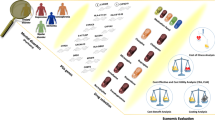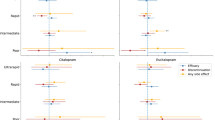Abstract
The pharmacokinetics of many antidepressants (tricyclic antidepressants (TCA) or selective serotonin re-uptake inhibitors (SSRI)) are influenced by the highly polymorphic CYP2D6 enzyme. Therefore, pharmacogenetics could play an important role in the treatment of depressive patients. The potential cost-utility of screening patients is however still unknown. Therefore, a Markov model was developed to compare the strategy of screening for CYP2D6 and subsequently adjust antidepressant treatment according to a patient’s metabolizer profile of poor, extensive, or ultra metabolizer, with the strategy of no screening (‘one size fits all’ principle). Each week a patient had a probability of side effects, which was followed by dosage titration or treatment switching. After 6 weeks treatment effect was evaluated followed by treatment adjustments if necessary, with a total time horizon of the model of 12 weeks. The analysis was performed from a societal perspective. The strategy of screening compared with no screening resulted in incremental costs of €91 (95 percentiles: €39; €152) more expensive but also more effect with 0.001 quality adjusted life years (QALYs) (95 percentiles: 0.001; 0.002) gain. The incremental cost-effectiveness ratio (ICER) was therefore €77,406 per QALY gained, but varied between €22,500 and €377,500 depending on the price of screening and productivity losses. According to our model, we cannot unequivocally conclude that screening for CYP2D6 in primary care patients using antidepressants is be cost-effective, as the results are surrounded by large uncertainty. Therefore, information from ongoing studies should be used to reduce these uncertainties.
This is a preview of subscription content, access via your institution
Access options
Subscribe to this journal
Receive 6 print issues and online access
$259.00 per year
only $43.17 per issue
Buy this article
- Purchase on Springer Link
- Instant access to full article PDF
Prices may be subject to local taxes which are calculated during checkout



Similar content being viewed by others
References
WHO Regional Office for Europe (WHO/Europe). Mental health—data and statistics. http://www.euro.who.int/en/health-topics/noncommunicable-diseases/mental-health. Accessed 02 Feb 2017.
Gustavsson A, Svensson M, Jacobi F, Allgulander C, Alonso J, Beghi E, et al. Cost of disorders of the brain in Europe 2010. Eur Neuropsychopharmacol. 2011;21:718–79.
Kirchheiner J, Nickchen K, Bauer M, Wong ML, Licinio J, Roots I, et al. Pharmacogenetics of antidepressants and antipsychotics: the contribution of allelic variations to the phenotype of drug response. Mol Psychiatry. 2004;9:442–73.
Fabbri C, Di Girolamo G, Serretti A. Pharmacogenetics of antidepressant drugs: an update after almost 20 years of research. Am J Med Genet B Neuropsychiatr Genet. 2013;162B:487–520.
Spijker J, Bockting CLH, Meeuwissen JAC, Van Vliet IM, Emmelkamp PMG, Hermens MLM, et al. Multidisciplinaire richtlijn Depressie (Derde revisie). Richtlijn voor de diagnostiek, behandeling en begeleiding van volwassen patiënten met een depressieve stoornis. Utrecht: Trimbos-instituut; 2013.
Kelly K, Posternak M, Alpert JE. Toward achieving optimal response: understanding and managing antidepressant side effects. Dialogues Clin Neurosci. 2008;10:409–18.
Cheung AH, Emslie GJ, Mayes TL. Review of the efficacy and safety of antidepressants in youth depression. J Child Psychol Psychiatry. 2005;46:735–54.
Kok RM, Nolen WA, Heeren TJ. Efficacy of treatment in older depressed patients: a systematic review and meta-analysis of double-blind randomized controlled trials with antidepressants. J Affect Disord. 2012;141:103–15.
Bertilsson L, Dahl ML, Dalen P, Al-Shurbaji A. Molecular genetics of CYP2D6: clinical relevance with focus on psychotropic drugs. Br J Clin Pharmacol. 2002;53:111–22.
Kirchheiner J, Brosen K, Dahl ML, Gram LF, Kasper S, Roots I, et al. CYP2D6 and CYP2C19 genotype-based dose recommendations for antidepressants: a first step towards subpopulation-specific dosages. Acta Psychiatr Scand. 2001;104:173–92.
Rau T, Wohlleben G, Wuttke H, Thuerauf N, Lunkenheimer J, Lanczik M, et al. CYP2D6 genotype: impact on adverse effects and nonresponse during treatment with antidepressants-a pilot study. Clin Pharmacol Ther. 2004;75:386–93.
Bijl MJ, Visser LE, Hofman A, Vulto AG, van Gelder T, Stricker BH, et al. Influence of the CYP2D6*4 polymorphism on dose, switching and discontinuation of antidepressants. Br J Clin Pharmacol. 2008;65:558–64.
Hodgson K, Tansey K, Dernovsek MZ, Hauser J, Henigsberg N, Maier W, et al. Genetic differences in cytochrome P450 enzymes and antidepressant treatment response. J Psychopharmacol. 2014;28:133–41.
Schenk PW, van Fessem MA, Verploegh-Van Rij S, Mathot RA, van Gelder T, Vulto AG, et al. Association of graded allele-specific changes in CYP2D6 function with imipramine dose requirement in a large group of depressed patients. Mol Psychiatry. 2008;13:597–605.
Drozda K, Muller DJ, Bishop JR. Pharmacogenomic testing for neuropsychiatric drugs: current status of drug labeling, guidelines for using genetic information, and test options. Pharmacotherapy. 2014;34:166–84.
Muller DJ, Kekin I, Kao AC, Brandl EJ. Towards the implementation of CYP2D6 and CYP2C19 genotypes in clinical practice: update and report from a pharmacogenetic service clinic. Int Rev Psychiatry. 2013;25:554–71.
Bradford LD. CYP2D6 allele frequency in European Caucasians, Asians, Africans and their descendants. Pharmacogenomics. 2002;3:229–43.
Van Schaik RH, Van Fessem MA, Schenk PW, Lindemans J. CYP2D6-genotypen in de Nederlandse populatie, bepaald met de Roche AmpliChip CYP450. Ned Tijdschr Klin Chem Labgeneesk. 2006;31:234–5.
Mulder H, Herder A, Wilmink FW, Tamminga WJ, Belitser SV, Egberts AC. The impact of cytochrome P450-2D6 genotype on the use and interpretation of therapeutic drug monitoring in long-stay patients treated with antidepressant and antipsychotic drugs in daily psychiatric practice. Pharmacoepidemiol Drug Saf. 2006;15:107–14.
Shams ME, Arneth B, Hiemke C, Dragicevic A, Muller MJ, Kaiser R, et al. CYP2D6 polymorphism and clinical effect of the antidepressant venlafaxine. J Clin Pharm Ther. 2006;31:493–502.
Gressier F, Verstuyft C, Hardy P, Becquemont L, Corruble E. Response to CYP2D6 substrate antidepressants is predicted by a CYP2D6 composite phenotype based on genotype and comedications with CYP2D6 inhibitors. J Neural Transm. 2015;122:35–42.
Swen JJ, Nijenhuis M, de Boer A, Grandia L, Maitland-van der Zee AH, Mulder H, et al. Pharmacogenetics: from bench to byte—an update of guidelines. Clin Pharmacol Ther. 2011;89:662–73.
Relling MV, Klein TE. CPIC: Clinical Pharmacogenetics Implementation Consortium of the Pharmacogenomics Research Network. Clin Pharmacol Ther. 2011;89:464–7.
Swen JJ, Guchelaar HJ. Just how feasible is pharmacogenetic testing in the primary healthcare setting? Pharmacogenomics. 2012;13:507–9.
D’Empaire I, Guico-Pabia CJ, Preskorn SH. Antidepressant treatment and altered CYP2D6 activity: are pharmacokinetic variations clinically relevant? J Psychiatr Pract. 2011;17:330–9.
Relling MV, Evans WE. Pharmacogenomics in the clinic. Nature. 2015;526:343–50.
Janssens AC, Deverka PA. Useless until proven effective: the clinical utility of preemptive pharmacogenetic testing. Clin Pharmacol Ther. 2014;96:652–4.
Veenstra DL. The value of routine pharmacogenomic screening-are we there yet? A perspective on the costs and benefits of routine screening-shouldn’t everyone have this done? Clin Pharmacol Ther. 2016;99:164–6.
Swen JJ, Huizinga TW, Gelderblom H, de Vries EG, Assendelft WJ, Kirchheiner J, et al. Translating pharmacogenomics: challenges on the road to the clinic. PLoS Med. 2007;4:e209.
Drummond M. Methods for the economic evaluation of health care programmes. Oxford medical publications. 3rd ed. Oxford, New York: Oxford University Press; 2005. p. 379.
Briggs AH, Claxton K, Sculpher MJ. Decision modelling for health economic evaluation. Oxford handbooks in health economic evaluation. Oxford: Oxford University Press; 2006. p. 237.
Russell LB. Modelling for cost-effectiveness analysis. Stat Med. 1999;18:3235–44.
Van Weel-Baumgarten EM, Van Gelderen MG, Grundmeijer HGLM, Licht-Strunk E, Van Marwijk HWJ, Van Rijswijk HCAM, et al. NHG-Standaard Depressie (tweede herziening). Huisarts Wet. 2012;55:252–9.
Rush AJ, Trivedi MH, Wisniewski SR, Nierenberg AA, Stewart JW, Warden D, et al. Acute and longer-term outcomes in depressed outpatients requiring one or several treatment steps: a STAR*D report. Am J Psychiatry. 2006;163:1905–17.
Annemans L, Brignone M, Druais S, De Pauw A, Gauthier A, Demyttenaere K. Cost-effectiveness analysis of pharmaceutical treatment options in the first-line management of major depressive disorder in Bellgium. PharmacoEconomics. 2014;32:479–93.
Zorginstituut Nederland. Drug costs. http://medicijnkosten.nl/. Accessed 01 Feb 2017.
Zorginstituut Nederland. Richtlijn voor het uitvoeren van economische evaluaties in de gezondheidszorg (verdiepingsmodules). 2016. p. 120. https://www.zorginstituutnederland.nl/binaries/zinl/documenten/publicatie/2016/02/29/richtlijn-voor-het-uitvoeren-van-economische-evaluaties-in-de-gezondheidszorg/Richtlijn+voor+het+uitvoeren+van+economische+evaluaties+in+de+gezondheidszorg+%28verdiepingsmodules%29.pdf.
Demyttenaere K, Hemels ME, Hudry J, Annemans L. A cost-effectiveness model of escitalopram, citalopram,and venlafaxine as first-line treatment for major depressive disorder in Belgium. Clin Ther. 2005;27:111–24.
De Graaf R, Ten Have M, Van Dorsselaer S. De psychische gezondheid van de Nederlandse bevolking. NEMESIS-2: Opzet en eerste resultaten. Utrecht: Trimbos-instituut; 2010.
de Graaf R, Tuithof M, van Dorsselaer S, ten Have M. Comparing the effects on work performance of mental and physical disorders. Soc Psychiatry Psychiatr Epidemiol. 2012;47:1873–83.
CBS Statline. Consumer price index. http://statline.cbs.nl/. Accessed 11 Jan 2017.
Koeser L, Donisi V, Goldberg DP, McCrone P. Modelling the cost-effectiveness of pharmacotherapy compared with cognitive-behavioural therapy and combination therapy for the treatment of moderate to severe depression in the UK. Psychol Med. 2015;45:3019–31.
U-PGx Consortium. Ubiquitous pharmacogenomics (U-PGx). http://upgx.eu/. Accessed 06 Nov 2016.
Mulder H, Wilmink FW, Beumer TL, Tamminga WJ, Jedema JN, Egberts AC. The association between cytochrome P450 2D6 genotype and prescription patterns of antipsychotic and antidepressant drugs in hospitalized psychiatric patients: a retrospective follow-up study. J Clin Psychopharmacol. 2005;25:188–91.
Cipriani A, Santilli C, Furukawa TA, Signoretti A, Nakagawa A, McGuire H, et al. Escitalopram versus other antidepressive agents for depression. Cochrane Database Syst Rev. 2009; CD006532.
Lobello KW, Preskorn SH, Guico-Pabia CJ, Jiang Q, Paul J, Nichols AI, et al. Cytochrome P450 2D6 phenotype predicts antidepressant efficacy of venlafaxine: a secondary analysis of 4 studies in major depressive disorder. J Clin Psychiatry. 2010;71:1482–7.
Berm EJ, Looff M, Wilffert B, Boersma C, Annemans L, Vegter S, et al. Economic evaluations of pharmacogenetic and pharmacogenomic screening tests: a systematic review. Second update of the literature. PloS ONE. 2016;11:e0146262.
Wallerstedt SM, Lindh JD. Prevalence of therapeutic drug monitoring for antidepressants and antipsychotics in Stockholm, Sweden: a longitudinal analysis. Ther Drug Monit. 2015;37:461–5.
Preskorn SH, Kane CP, Lobello K, Nichols AI, Fayyad R, Buckley G, et al. Cytochrome P450 2D6 phenoconversion is common in patients being treated for depression: implications for personalized medicine. J Clin Psychiatry. 2013;74:614–21.
Funding
An unrestricted grant was received from Royal Dutch Pharmacists Association (KNMP), The Hague, in The Netherlands. The funding body had no role in the analysis or interpretation of the findings of this article.
Author information
Authors and Affiliations
Corresponding author
Ethics declarations
Conflict of interest
The authors declare that they have no conflict of interest.
Additional information
Publisher’s note: Springer Nature remains neutral with regard to jurisdictional claims in published maps and institutional affiliations.
Rights and permissions
About this article
Cite this article
Sluiter, R.L., Janzing, J.G.E., van der Wilt, G.J. et al. An economic model of the cost-utility of pre-emptive genetic testing to support pharmacotherapy in patients with major depression in primary care. Pharmacogenomics J 19, 480–489 (2019). https://doi.org/10.1038/s41397-019-0070-8
Received:
Revised:
Accepted:
Published:
Issue Date:
DOI: https://doi.org/10.1038/s41397-019-0070-8
This article is cited by
-
Cost-effectiveness of artificial intelligence screening for diabetic retinopathy in rural China
BMC Health Services Research (2022)
-
A Promising Approach to Optimizing Sequential Treatment Decisions for Depression: Markov Decision Process
PharmacoEconomics (2022)
-
Cost–Utility Analysis of Pharmacogenetic Testing Based on CYP2C19 or CYP2D6 in Major Depressive Disorder: Assessing the Drivers of Different Cost-Effectiveness Levels from an Italian Societal Perspective
Clinical Drug Investigation (2022)
-
Economic evaluation in psychiatric pharmacogenomics: a systematic review
The Pharmacogenomics Journal (2021)



